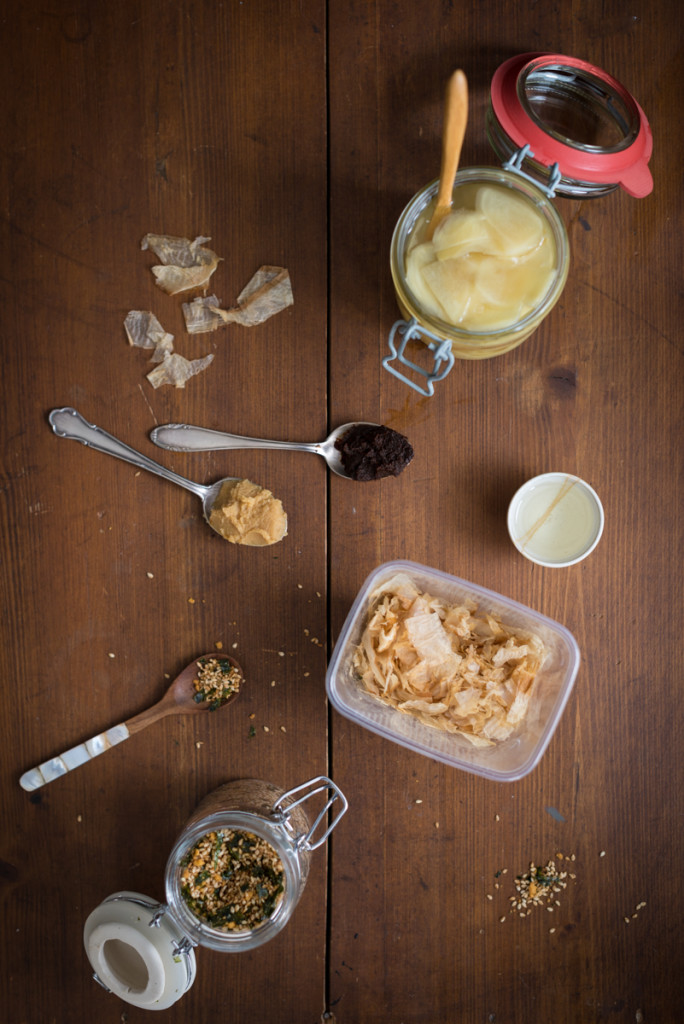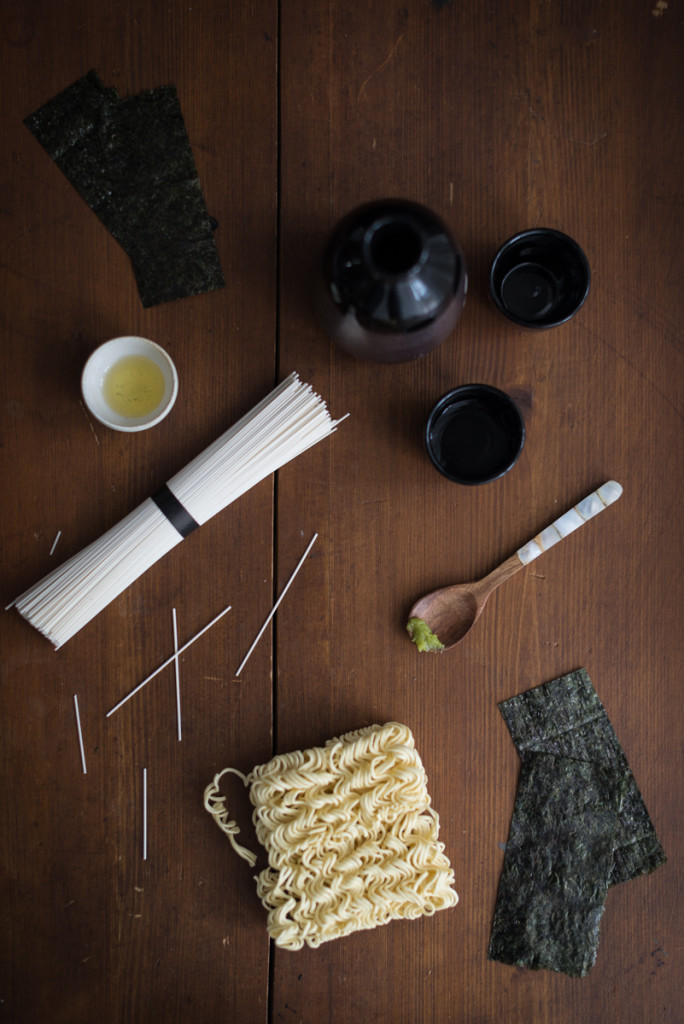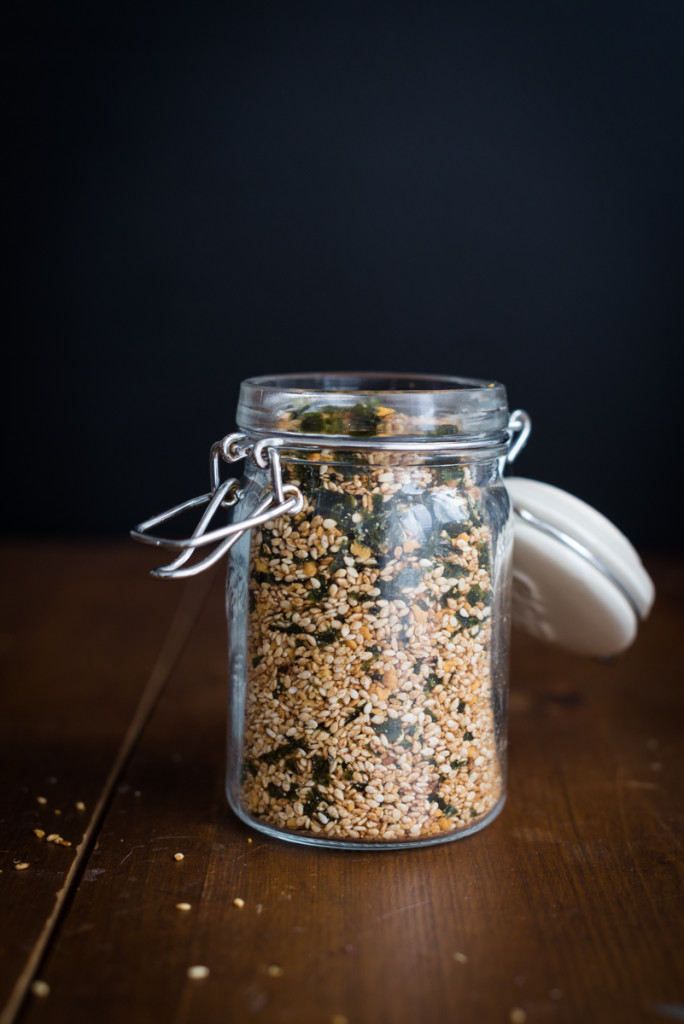We continue with stocking up our pantry with basic ingredients for Japanese cooking. In the last part we talked about the (at least in my opinion) five most important ingredients and how to make perfectly steamed rice. Today I will list ten more basic ingredients that you will need if you want to cook Japanese. In the next part I will show you different kinds of noodles before going over to fresh groceries, other ingredients, and giving you a few tips about Japanese cooking itself.
In this list I want to stay away from product placement. First I am still testing myself which ingredients I like most. And second a lot of it depends on personal taste anyway. If you still want to know which ingredient of what producer etc. I prefer, please feel free to ask. This goes for questions about the cooking itself as well. I will be happy to answer your questions.
Additional 10 Basic Ingredients for the Japanese Kitchen
These ten ingredients you will find a lot in Japanese recipes. Despite they are all essential and mostly there a no substitutes for them, you won’t need every single one of them from the beginning. Experiment with one ingredient after another and try what you like.
As I already wrote in the last post: I can give you the advice to shop for Japanese ingredients in an Asian supermarket (at least if you live in Germany). You will find the ingredients you can buy there are much more authentic, tastier, and mostly even cheaper than in the „usual“ supermarkets (which tend to sell sub-standard goods and that for a much too high price).
Gari (vegan). It’s never wrong to have gari at home, especially if you’re as much of a sushi monster as I am. Essentially this pickled ginger is to neutralize your pelt between eating different kind of fish bites. But I also like to experiment with it and use it in other dishes as well. Good gari (I just can repeat myself) you will find in Asian supermarkets. You want a gari that is so delicious you won’t be able to stop eating it? Just make it yourself. It is very easy – the recipe is here. There is no substitute for gari.
Miso, different varieties (mostly vegan, sometimes gluten-free). Miso is a paste out of fermented soy beans and the consistency reminds of tomato paste. You usually use it for soups, sauces and seasoning. Miso comes in many varieties that are usually categorized by their colour. There is white, yellow, and red miso and some in between. Miso can also contain rice, wheat, or barley, so it isn’t necessarily gluten-free! Some types also contain additional ingredients like fish, so always check the package if you are allergic to some ingredients or you don’t want your miso with them. The rule of thumb says: The darker the miso the spicier it is. If you want to read more about miso you can look here, here or here. I always have at least one light and one dark miso paste in the fridge. There is no substitute for miso.
Peanut oil (vegan, gluten-free). Or another oil you can use at very high heat like sunflower oil or soy oil. It is important for frying at high temperatures, which you will do whilst cooking Japanese – especially if you use a wok.
Bonito flakes (gluten-free). Like kombu bonito flakes are used for the traditional dashi. In my opinion they are not as important as kombu, because you can leave them out completely. Bonito is a variety of tuna. For these flavourful flakes the fish is dried and then sliced very thinly. Vegetarian dashi contains just kombu (which is also the foundation for miso soup) or you can add shiitake mushrooms. Good bonito flakes you can recognize by big flakes in the package. There is no substitute for bonito flakes as well.
Sesame, light or dark, and furikake (vegan, mostly gluten-free). You need sesame for the finishing touch – in Japan it is not only important how a dish tastes like but also how it looks. Sprinkle a little bit of sesame over your dish and it will look and taste a little better already. You can also use furikake, which is nothing more than toasted and seasoned sesame. There are a lot of varieties, so keep your eyes open for them… or (even better) make it yourself. A recipe is at the end of this post.
Sake (vegan, mostly gluten-free). Sake is a Japanese rice liquor and it is usually served warm. Good sake tastes mild, almost flowery or nutty, and somewhere between mildly bitter and sweet. You also use it for cooking: in sauces or for deglazing for example. If you like to drink sake you should buy a bottle, otherwise you can use a medium dry sherry as a substitute for cooking.
Sesame oil (vegan, gluten-free). For some it might be dispensable but it is just great for refining your dishes, especially when it comes to soups! If you should want to buy one, buy a high quality one. You recognize good quality best when you taste it: It should be very aromatic and nutty but still mild with no displeasing tone to it. You only need a few drops per dish, so one bottle will suffice quite a while.
Wasabi (vegan, mostly gluten-free). You can buy wasabi as a powder, as paste or even as oil (be careful: the oil is very, very hot!). I personally prefer the paste most of the time and use the oil only in special cases. The paste might also be the one single Japanese ingredient you won’t be disappointed of, if buying it in an usual supermarket. If you can’t find wasabi leave it out completely. Horseradish is related to it but it is definitely not a substitute.
Nori (vegan, gluten-free). Some hate it, I can’t live without it. Nori is seaweed that has been pressed to sheets and roasted. It is one of the main ingredients for sushi rolls, though it is used for other dishes too. There are a few differences in quality and taste, so feel free to buy different varieties and try which one you like most. Nori is best cut with scissors and if you opened a package you can store it in those airtight zip-lock bags in your pantry.
By the way: Nori contains a high amount of iodine, so you should not overdo it with the eating because it can end very badly for your thyroid gland. Make sure to check the instructions on the packaging. Usually one or two sheets is the maximum you should eat per day.
Japanese noodles (mostly vegan, sometimes gluten-free). I will talk more about noodles in the next part. Still: Japanese noodles are essential for a Japanese pantry. Mostly they resemble short spaghetti and they are used for soups and wok dishes. They differ in their thickness and the containing ingredients which influence taste and consistency.
Furikake with Nori
Ingredients for 1 glass (250 ml)
- 250 ml light and/or dark sesame
- 25 ml soy sauce (or 25 ml water mixed with 1-2 tsp salt)
- 25 ml water
- 1-2 sheets nori
Put the sesame in a pan and put it on medium heat. Shake the pan or stir from time to time to let the sesame roast evenly. After 15 minutes or so the sesame should be slightly brown. Mix soy sauce and water and pour it over the sesame into the pan whilst stirring. Keep on roasting the sesame at medium heat until it is completely dry and it is rustling in the pan when you stir.
Switch off the heat and let the sesame cool down to room temperature completely. Cut the nori into very small pieces. I prefer using scissors for that: First I cut it in stripes, bundle them, and then cut them in short pieces.
Mix sesame and nori and store it in airtight containers. It will keep fresh in your pantry for many weeks in theory… but it always tastes too damn good! use it on steamed rice, sushi, noodles, fried fish, beef, cooked vegetables, omelette, or whatever you like.





In Nagoya they have some “special Miso” that they use like ketchup. Nagoya people like to have this kind of miso to everything, for example to Katsu, which is something like a German pork Schnitzel, just with a more thick and crunchy coating.
That sounds awesome. Does this miso have a special name?
Thanks, Jan! 🙂